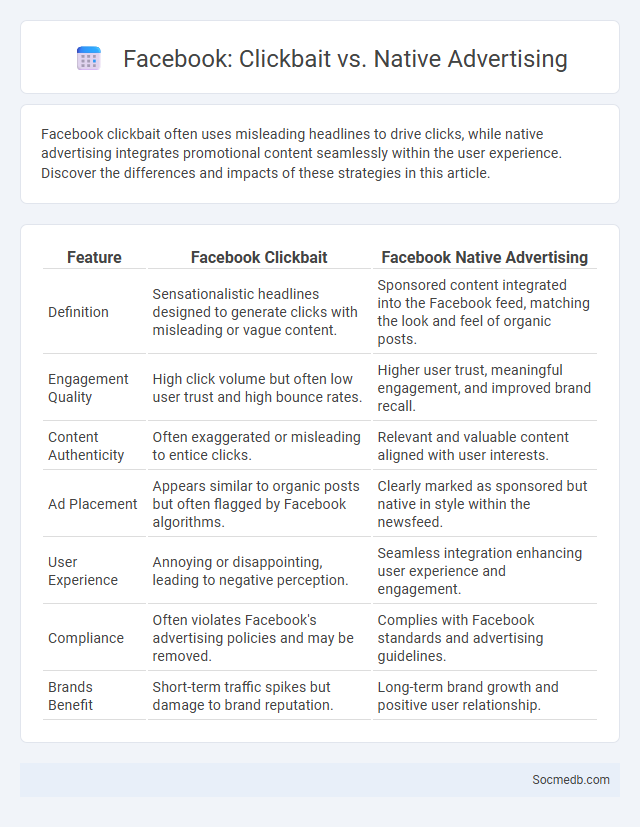
Photo illustration: Facebook clickbait vs native advertising
Facebook clickbait often uses misleading headlines to drive clicks, while native advertising integrates promotional content seamlessly within the user experience. Discover the differences and impacts of these strategies in this article.
Table of Comparison
| Feature | Facebook Clickbait | Facebook Native Advertising |
|---|---|---|
| Definition | Sensationalistic headlines designed to generate clicks with misleading or vague content. | Sponsored content integrated into the Facebook feed, matching the look and feel of organic posts. |
| Engagement Quality | High click volume but often low user trust and high bounce rates. | Higher user trust, meaningful engagement, and improved brand recall. |
| Content Authenticity | Often exaggerated or misleading to entice clicks. | Relevant and valuable content aligned with user interests. |
| Ad Placement | Appears similar to organic posts but often flagged by Facebook algorithms. | Clearly marked as sponsored but native in style within the newsfeed. |
| User Experience | Annoying or disappointing, leading to negative perception. | Seamless integration enhancing user experience and engagement. |
| Compliance | Often violates Facebook's advertising policies and may be removed. | Complies with Facebook standards and advertising guidelines. |
| Brands Benefit | Short-term traffic spikes but damage to brand reputation. | Long-term brand growth and positive user relationship. |
Understanding Facebook Clickbait: Definition and Impact
Facebook clickbait refers to sensationalized headlines or content designed to attract clicks by exploiting users' curiosity or emotions, often leading to misleading or low-quality information. This practice significantly impacts user experience by reducing content credibility, increasing misinformation spread, and skewing algorithmic content distribution on the platform. Understanding Facebook clickbait is crucial for developing effective strategies to enhance digital literacy and improve content moderation policies.
What is Native Advertising? Key Features Explained
Native advertising seamlessly integrates promotional content into the natural flow of social media feeds, making ads appear less intrusive and more engaging for users. It matches the design, style, and tone of the platform, enhancing click-through rates and user interaction. Your brand benefits from increased visibility and trust as native ads blend contextually with organic content on platforms like Instagram, Facebook, and Twitter.
Clickbait Explained: Strategies and Examples
Clickbait employs sensational headlines and intriguing images to attract Your clicks and increase engagement by exploiting curiosity gaps. Common strategies include using numbers, provocative questions, and emotional triggers designed to compel users to open links. Successful examples often promise surprising revelations or exclusive content, driving high click-through rates across platforms like Facebook and Instagram.
Facebook Clickbait vs Native Advertising: Key Differences
Facebook clickbait manipulates headlines and images to entice clicks, often leading to low-quality or misleading content that can harm your brand's credibility. In contrast, native advertising integrates seamlessly with Facebook's platform, presenting sponsored content that aligns with user interests and enhances engagement without disrupting the user experience. Understanding these key differences ensures your marketing strategy prioritizes genuine interaction and long-term audience trust.
Comparing Audience Engagement: Clickbait vs Native Ads
Clickbait often generates high initial clicks through sensational headlines but tends to result in lower long-term audience engagement and trust. Native ads blend seamlessly with platform content, providing more relevant and less intrusive experiences that encourage deeper interaction and brand affinity. To enhance Your social media strategy, prioritizing native ads can improve genuine connection and sustained audience engagement compared to clickbait tactics.
Effectiveness of Clickbait on Social Media Platforms
Clickbait headlines often generate high engagement rates by exploiting curiosity gaps and emotional triggers, leading to increased clicks and shares on social media platforms like Facebook, Twitter, and Instagram. Studies indicate that despite higher click-through rates, clickbait content frequently results in lower user trust and reduced long-term audience retention. Social media algorithms tend to amplify clickbait, prioritizing content with high initial interaction metrics, which significantly impacts content visibility and viral potential.
Trust and Credibility: Native Advertising vs Clickbait
Native advertising fosters trust and credibility by seamlessly integrating promotional content within relevant, high-quality environments, aligning with user expectations and minimizing disruption. Clickbait, however, often sacrifices integrity by using sensationalized headlines that mislead audiences, leading to skepticism and diminished brand reputation. Brands leveraging native advertising benefit from higher engagement and sustained consumer trust compared to the short-term attention generated by clickbait tactics.
Platform Policies on Clickbait and Native Advertising
Social media platforms enforce strict policies against clickbait to improve user experience by reducing misleading headlines and sensationalized content designed solely to attract clicks. Native advertising must be clearly labeled and integrated in a way that maintains transparency, preventing deceptive practices that blur the lines between organic content and paid promotions. Compliance with these platform regulations is essential for advertisers and content creators to avoid penalties and ensure credibility.
Best Practices for Ethical Advertising on Facebook
Ethical advertising on Facebook requires transparency, honesty, and respect for user privacy to build trust and maintain brand integrity. You should clearly disclose sponsored content, avoid misleading claims, and comply with Facebook's advertising policies to prevent account suspension or legal issues. Prioritizing authentic engagement and data protection will enhance your campaign's effectiveness and ensure sustainable audience relationships.
Future Trends: Native Advertising and Clickbait Evolution
Social media trends are rapidly shifting towards more sophisticated native advertising that seamlessly integrates branded content within users' feeds, enhancing engagement without disrupting user experience. The evolution of clickbait now involves smarter algorithms and personalized headlines designed to increase click-through rates while maintaining content relevance and authenticity. Emerging technologies like AI-driven content creation and augmented reality are transforming how advertisers capture attention in increasingly saturated social platforms.
 socmedb.com
socmedb.com